Section 2.2. Attributes
2.2. AttributesDetails of a class (the color of a car, the number of sides in a shape, etc.) are represented as attributes. Attributes can be simple primitive types (integers, floating-point numbers, etc.) or relationships to other, complex objects (see "Relationships"). An attribute can be shown using two different notations: inlined or relationships between classes. In addition, notation is available to show such things as multiplicity, uniqueness, and ordering. This section introduces both notations, and then describes the details of the attribute specification. 2.2.1. Inlined AttributesYou can list a class's attributes right in rectangle notation; these are typically called inlined attributes. There is no semantic difference between inlined attributes and attributes by relationship; it's simply a matter of how much detail you want to present (or, in the case of primitives like integers, how much detail you can present). To represent an attribute within the body of a class, place the attribute in the second compartment of the class. UML refers to inlined attributes as attribute notation. Inlined attributes use the following notation: visibility / name : type multiplicity = default {property strings and constraints} visibility ::= {+|-|#|~} multiplicity ::= [lower..upper] Figure 2-3 lists several attributes, demonstrating various aspects of attribute notation. Figure 2-3. Example attributes The syntax elements are:
2.2.2. Attributes by RelationshipYou may also represent attributes using the relationship notation. The relationship notation results in a larger class diagram, but it can provide greater detail for complex attribute types. The relationship notation also conveys exactly how the attribute is contained within a class (see "Relationships" for information on the types of relationships). For example, if you are modeling a Car, you can show that a car contains an Engine much more clearly using relationships than you can just by listing an attribute in the Car's rectangle. However, showing the Car's name by relationship is probably overkill because it is likely just a string. To represent an attribute using relationships you use one of the association relationships between the class containing the attribute and the class that represents the attribute, as shown in Figure 2-4, which shows that the relationship between a car and its engine has a multiplicity of 1; a car has one engine. Figure 2-4. Attribute using relationship notation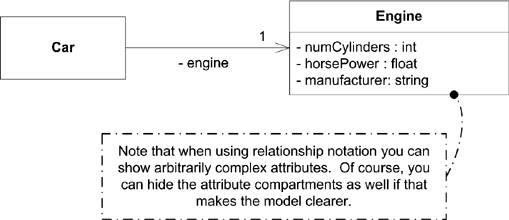
Relationship notation supports the same syntax as inlined notation, though the layout is slightly different. The attribute's visibility and name are placed near the relationship line. Don't use square brackets for multiplicity, but do place the multiplicity specification near the attribute's classifier. Like multiplicity, you can place constraints on attributes (see "Constraints"). In relationship notation, you write constraints near the attribute's classifier along the relationship line. UML allows relationship notation to also express constraints between attributes, as shown in Figure 2-5. Figure 2-5. Relationship notation using constraints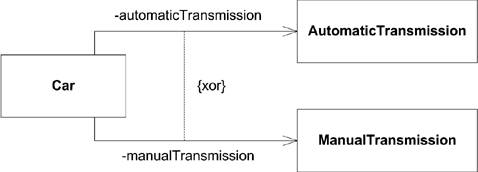 In Figure 2-5, the standard UML constraint xor shows that only automaticTransmission or manualTransmission can be set at any given time (exclusive or). You need to express this constraint in a note if the inlined attribute notation was used. 2.2.3. Derived AttributesThe derived notation, which is the leading forward slash (/), can be used as an indicator to the implementer that the attribute may not be strictly necessary. For example, let's say you modeled a bank account with a simple class named Account. This class stores the current balance as a floating-point number named balance. To keep track of whether this account is overdrawn, you add a boolean named overdrawn. Whether the account is overdrawn is really based on whether the balance is positive, not the boolean you added. You can indicate this to the developer by showing that overdrawn is a derived attribute, with its state based on balance. Figure 2-6 shows how balance and overdrawn can be represented using a note to convey the relationship. Figure 2-6. Derived attribute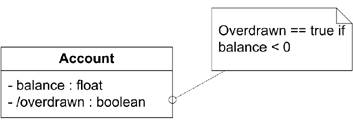 The UML specification notes that a derived attribute is typically readOnly, meaning a user may not modify the value. However, if a user is permitted to modify the value, the class is expected to update the source of the derived information appropriately. 2.2.4. Attribute MultiplicityThe multiplicity of an attribute specifies how many instances of the attribute's type are created when the owning class is instantiated. For example, our Car class will likely have four wheels, so the multiplicity of the wheel attribute is 4. If no multiplicity is specified, 1 is implied. Multiplicity can be a single integer, a list of integers separated by commas, or a range of values. When specifying a range of values, an infinite upper bound can be represented as an *; if no lower bound is specified, an * means zero or more. The multiplicity value is shown between square brackets as a single integer or as two integers separated by two dots (..). Figure 2-7 shows the various ways to represent an attribute's multiplicity. Figure 2-7. Multiplicity examples 2.2.4.1. OrderingAn attribute with a multiplicity greater than 1 can be specified to be ordered. If the attribute is ordered, the elements must be stored sequentially. For example, you can specify that a list of names be stored alphabetically by marking the list as ordered. Exactly what it means for attributes to be stored sequentially typically depends on the attribute type. By default, attributes are not ordered. To mark an attribute as ordered, specify the property ordered after the attribute in braces, as shown in Figure 2-8. Figure 2-8. Ordered multiplicity 2.2.4.2. UniquenessIn addition to being ordered, an attribute with multiplicity greater than 1 may be required to be unique. If an attribute is required to be unique, each element of this attribute must be unique. By default, attributes with multiplicity greater than 1 are unique, meaning there can be no duplicates in the elements this attribute holds. For example, if a class held a list of voters and each person was allowed to vote only once, each element in the list would be unique. To make an attribute unique, place the keyword unique after the attribute in braces, as shown in Figure 2-9. To allow an attribute to hold duplicates of an object, simply use the property not unique. Figure 2-9. Unique multiplicity 2.2.4.3. Collection typesThe UML specification specifies a set of mappings from the various ordered and uniqueness properties to UML collection types. Table 2-1 shows the mappings from attribute properties to the UML collection type. Note that the collection types shown in Table 2-1 are UML mappings and may not map directly to classes in a target language.
For example, to show that a bank's clients should be represented using an OrderedSet, you can model the clients attribute as shown in Figure 2-10. Figure 2-10. Example attribute stored in an OrderedSet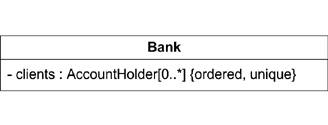 2.2.5. Attribute PropertiesIn addition to the properties associated with multiplicity, an attribute may have a number of properties set to convey additional information to the reader of the diagram. The common properties defined by UML are:
2.2.6. ConstraintsConstraints represent restrictions placed on an element. They may be natural language or use a formal grammar such as the OCL; however, they must evaluate to a boolean expression. You typically show constraints between curly braces ({}) after the element they restrict, though they may be placed in a note and linked to the element using a dashed line. You can name a constraint by specifying the name followed by a colon (:) before the boolean expression. This is frequently used to identify constraints on an operation (see "Operation Constraints"). Figure 2-11 shows several constraints on attributes and operations. Figure 2-11. Examples of inlined and note constraints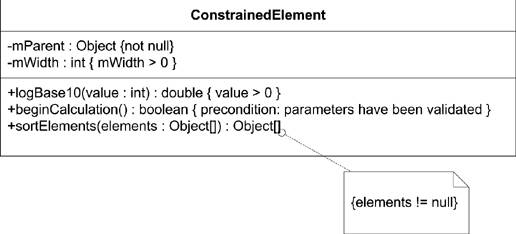 2.2.7. Static AttributesStatic attributes are attributes of the class rather than of an instance of the class. For example, you can initialize constant values for a class and share them between all instances of the class. You represent static attributes by underlining their specification in both inlined and relationship-based presentations, as shown in Figure 2-12. Figure 2-12. Static attribute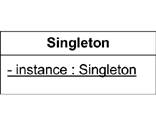 |
EAN: 2147483647
Pages: 132
- Chapter I e-Search: A Conceptual Framework of Online Consumer Behavior
- Chapter V Consumer Complaint Behavior in the Online Environment
- Chapter VIII Personalization Systems and Their Deployment as Web Site Interface Design Decisions
- Chapter XIII Shopping Agent Web Sites: A Comparative Shopping Environment
- Chapter XVI Turning Web Surfers into Loyal Customers: Cognitive Lock-In Through Interface Design and Web Site Usability
